Overview
In recent years, there has been a significant rise in autism diagnoses, with a staggering statistic revealing that 1 in 36 children in the U.S. is now diagnosed with autism. This increase is not merely a number; it reflects a growing awareness among parents and professionals alike. Factors contributing to this trend include:
- Enhanced understanding of autism
- Refined diagnostic criteria
- Better access to healthcare services
For many parents, this can be a source of concern, highlighting the pressing need for effective support systems and early interventions for those affected.
As parents, it’s natural to feel a mix of emotions when faced with such statistics. You may wonder what this means for your child and how to navigate these challenges. It’s important to remember that you are not alone in this journey. Many families are seeking answers and support, and there are resources available to help you understand and address your child's needs.
The urgency of creating supportive environments cannot be overstated. By advocating for early interventions and connecting with healthcare professionals, parents can play a crucial role in their child's development. Consider reaching out to local support groups or educational resources that can provide guidance and community. Together, we can foster a nurturing atmosphere that promotes understanding and growth for children on the autism spectrum.
Let’s engage in this conversation. Share your experiences and thoughts in the comments below, or subscribe to our newsletter for ongoing support and information. Your voice matters, and together we can create a brighter future for our children.
Introduction
The statistic that 1 in 36 children in the U.S. is diagnosed with autism serves as a poignant reminder of the increasing prevalence of this developmental disorder. This reality prompts essential discussions about its implications for families and society.
In this article, we will explore seven critical insights surrounding autism diagnosis trends, examining the factors contributing to this rise and the vital resources available for parents and professionals alike.
As the complexities of autism diagnosis evolve, how can families effectively navigate this landscape to ensure their children receive the support they need?
About ASD Media: Empowering Parents with Resources for Autism Support
At ASD Media, we are deeply committed to enhancing the application of Applied Behavior Analysis (ABA) therapy. Our mission is to provide valuable insights and strategies that address the challenges faced by individuals with developmental disorders, ultimately improving their outcomes. With an alarming statistic of 1 in 36 autism among children in the U.S. identified with a developmental disorder, the need for effective support has never been more critical. We offer a wide range of resources designed for both parents and professionals, creating a nurturing community where experiences can be shared and valuable lessons learned.
We empower parents and professionals to unlock the potential of children with ADHD by equipping them with effective strategies for managing challenging behaviors, navigating assistance services, and fostering social skills development. Community support is vital in the therapeutic journey for individuals with developmental conditions, as research shows that early intervention can lead to significantly better outcomes. Additionally, the average annual medical expenses for Medicaid-enrolled children with ASD are approximately $10,709 per child, highlighting the financial burden that families face. By subscribing to our newsletter, you can stay informed about the latest advancements in support for individuals with developmental disorders and gain unlimited digital access to essential resources.
Our goal at ASD Media is to cultivate a collaborative environment that not only addresses the challenges families encounter but also celebrates the achievements within the neurodiverse community. It is important to note that over 60% of children with autism spectrum disorder experience bullying, underscoring the social hurdles these individuals encounter. Furthermore, only 14% of adults on the autism spectrum are employed, indicating ongoing challenges that may concern parent advocates about their children's futures. By focusing on building relationships and sharing knowledge, ASD Media is dedicated to improving the lives of those affected by developmental disorders and fostering a culture of understanding.
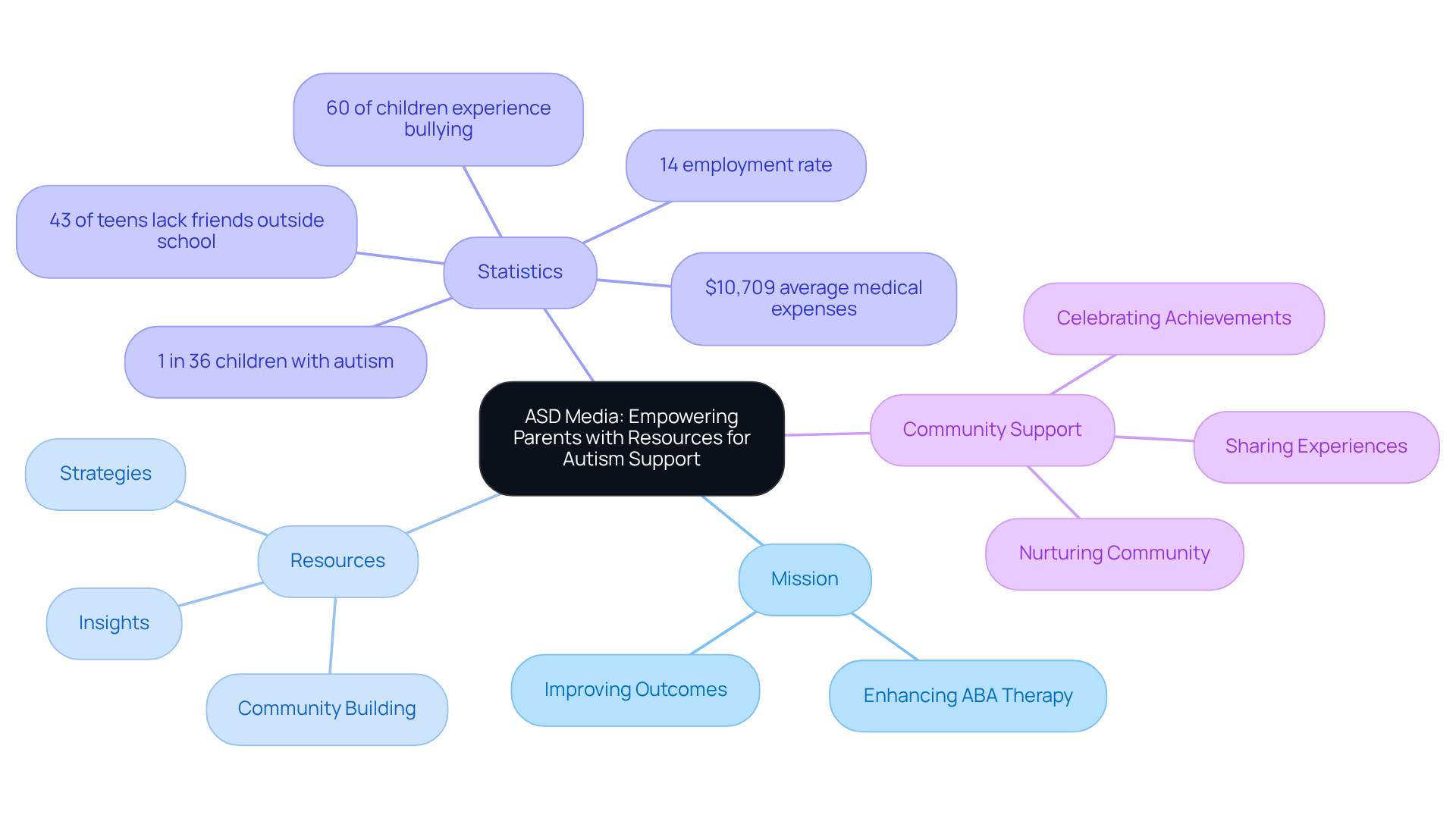
1 in 36 Children Diagnosed: Understanding the Rising Autism Prevalence
As of 2023, the statistics reveal that 1 in 36 autism diagnoses occur among youngsters in the U.S., a notable increase from approximately 1 in 150 in 2000. This alarming rise highlights the urgent need for effective support systems and interventions tailored to the unique challenges faced by autistic individuals.
Factors contributing to this increase include:
- Heightened awareness among parents and professionals
- Refined diagnostic criteria
- Improved access to healthcare services
For instance, in North Carolina, the occurrence of autism spectrum condition has risen from 1 in 500 young individuals in 2002 to 1 in 52 today, and this trend is reflected in the statistic of 1 in 36 autism across various states. Experts emphasize that these changes are not solely due to a genuine rise in cases; they also stem from better recognition and understanding of the condition.
Importantly, 78% of autistic children have at least one manageable mental health condition, underscoring the necessity for comprehensive assistance systems. The average age of diagnosis for developmental disorders in the U.S. is 5.0 years, which is crucial for early intervention. Chris Abildgaard points out that the increase in identified cases is a result of expanding definitions and improved diagnostic practices.
In this evolving landscape, it is essential for parents and professionals to stay informed and proactive in seeking resources and support to navigate the complexities of care for those on the autism spectrum.
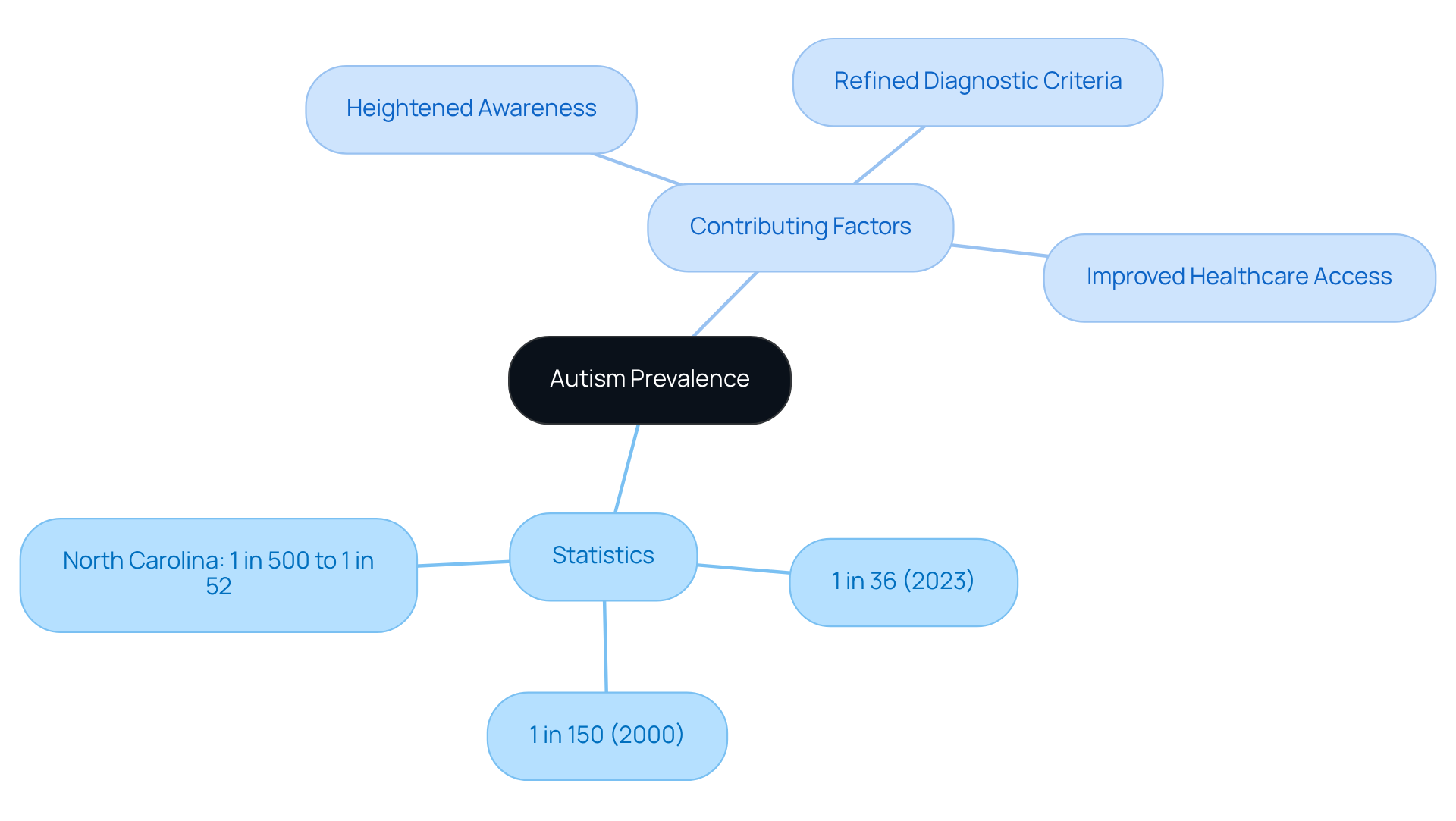
Young Adults and Autism: The Surge in Diagnosis Rates
Recent studies indicate a staggering 450% increase in developmental disorder diagnoses among young adults aged 26 to 34 over the past decade. This notable increase emphasizes the essential need for awareness and acknowledgment of the condition in adulthood, as many individuals may not receive a diagnosis until later in life. Andy Shih, chief science officer at Autism Speaks, highlights that this trend underscores the necessity of closing gaps in healthcare access for adults with developmental disorders.
Young adults with autism face unique obstacles. They often encounter challenges with:
- Social integration
- Restricted job opportunities
- Increased mental health concerns
In fact, adults are nearly three times more likely to experience mood, anxiety, or personality disorders than those diagnosed in childhood. These challenges can impede their ability to achieve independence and enhance their overall quality of life.
Therefore, it is essential to develop and implement effective assistance services tailored to meet the unique needs of this demographic. By ensuring they have the resources necessary to thrive, we can make a significant difference in their lives. As of April 15, 2025, the prevalence of developmental disorders in the U.S. has risen to 1 in 36 autism cases among children, further highlighting the necessity for comprehensive support systems. Together, we can advocate for change and provide the support these individuals so desperately need.
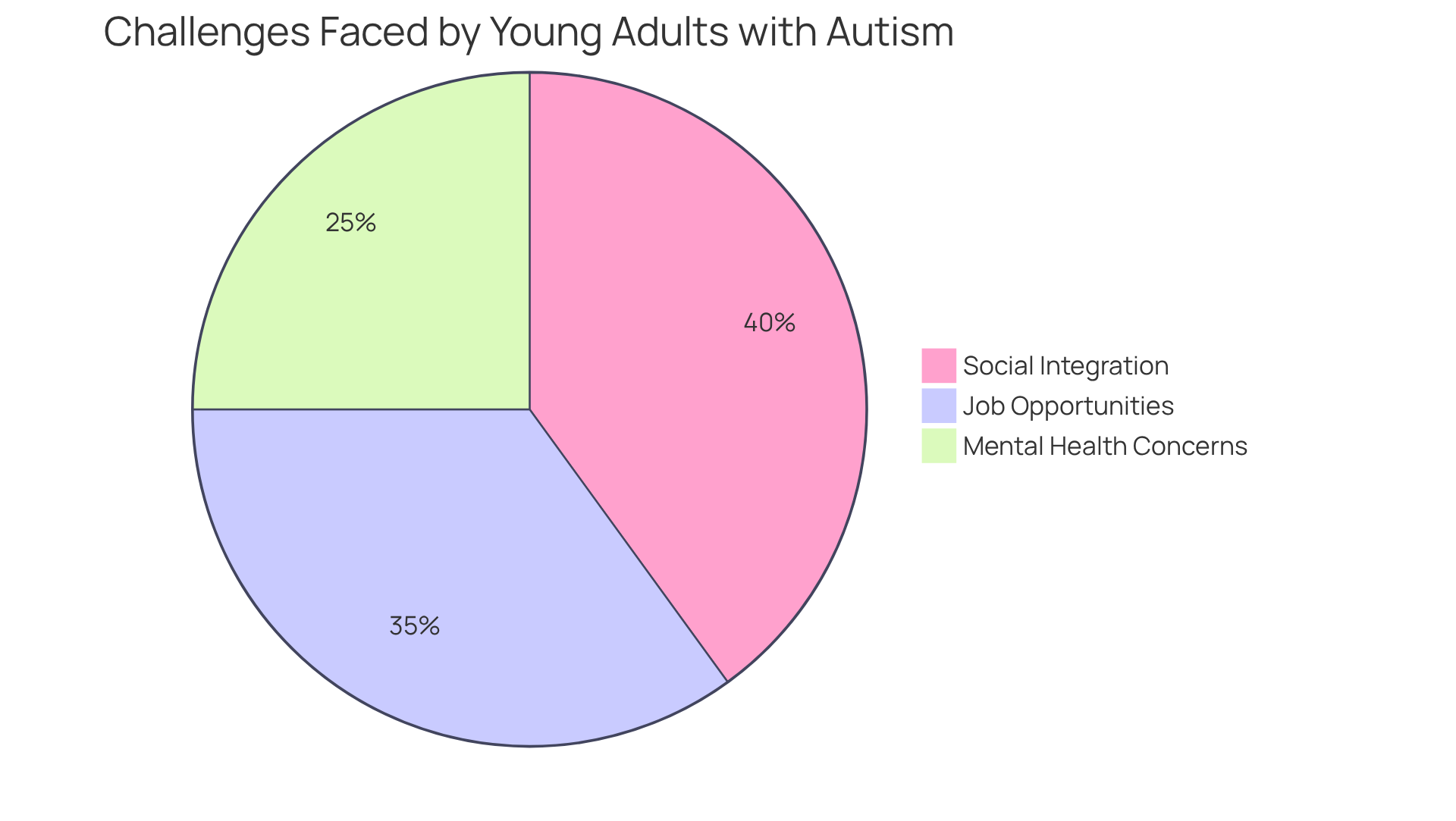
Gender Disparities: Boys Diagnosed with Autism 4.2 Times More Often Than Girls
Studies reveal a concerning reality: boys are identified with the condition at a rate 4.2 times greater than girls. This significant disparity prompts us to reflect on potential biases in diagnostic practices. It suggests that girls may be underdiagnosed, with the actual ratio possibly closer to 1 girl for every 2 or 3 boys. Women with this condition often exhibit subtler signs and may be more inclined to conceal their symptoms, which complicates the identification of the disorder.
Understanding these gender differences is crucial for developing effective support strategies tailored to the unique needs of both boys and girls on the spectrum. By addressing these biases, we not only enhance diagnostic accuracy but also ensure that every individual receives the appropriate interventions and resources necessary for their growth. It's particularly important to note that 40% of youth with this condition do not speak, highlighting the urgency of our response.
Moreover, the average age of diagnosis for this condition in the U.S. is around 5 years, underscoring the importance of timely interventions. The prevalence of ASD is projected to be 23.0 per 1,000 youths aged 8 years, which translates to approximately 1 in 36 autism cases, emphasizing the need to grasp gender differences within the broader context of ASD prevalence. Together, we can work towards a more inclusive understanding and support system for all children affected by this condition.
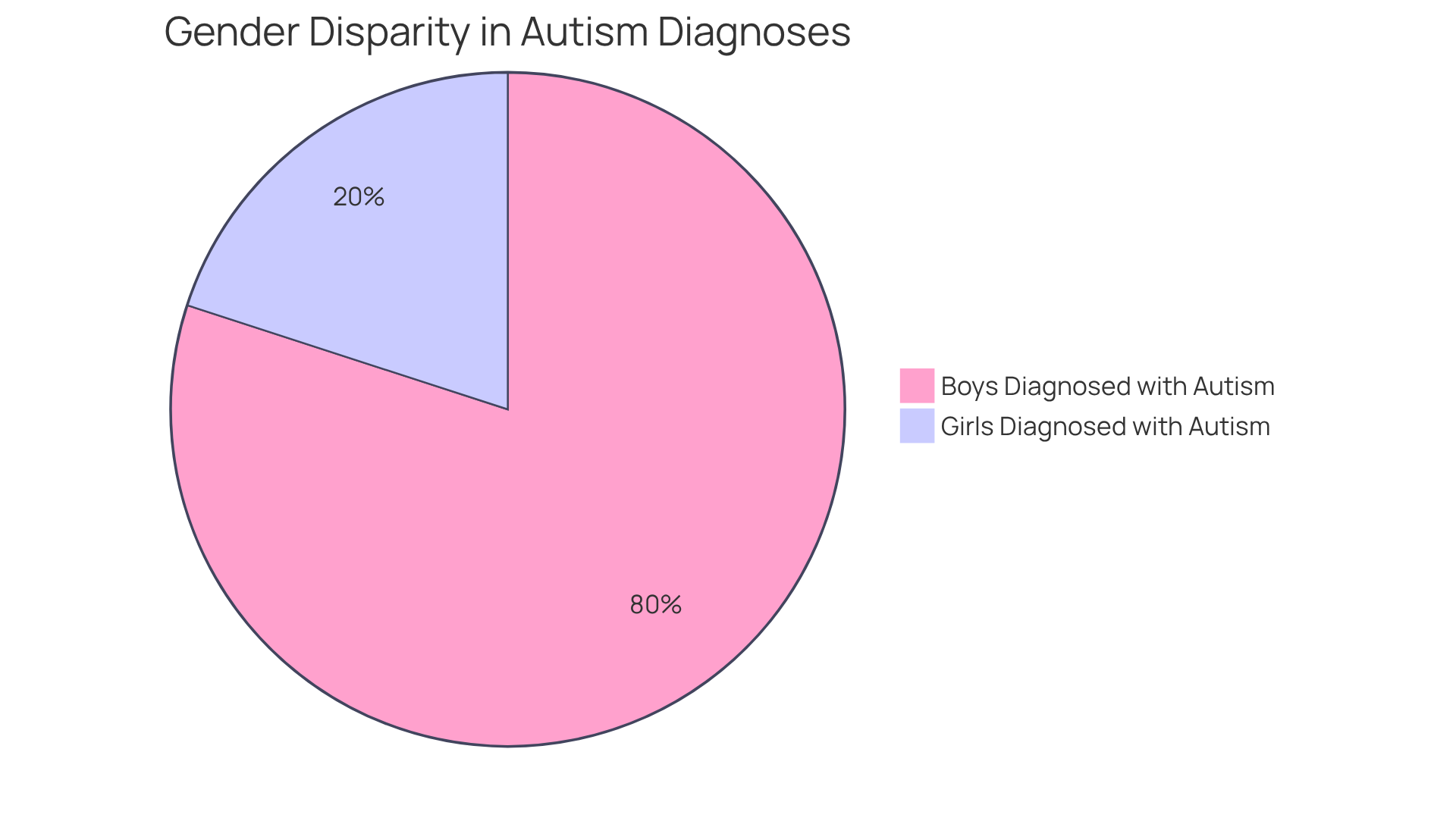
Parental Age and Autism: Exploring the Link to Diagnosis
As prospective parents, it's essential to be aware of the connection between advanced parental age and the increased risk of developmental disorders in children. Studies reveal that fathers over the age of 40 face a significantly higher likelihood of having a child diagnosed with a developmental disorder, with research indicating a 28% greater risk for children of fathers in their 40s compared to those in their 20s. This concern amplifies for fathers aged over 50, whose children are at a remarkable 66% increased risk of developmental disorders.
But it’s not just paternal age that matters; maternal age plays a crucial role too. Children of mothers in their 40s have a 15% higher chance of being diagnosed with a developmental disorder than those born to younger mothers. Interestingly, children born to adolescent mothers experience an 18% higher incidence of such conditions compared to those born to mothers in their 20s. These findings underscore the importance of considering age when planning for a family, especially as the trend of delayed parenthood becomes more common.
For families navigating the complexities of developmental disorders, understanding these risks is vital. A study involving over 5.7 million children across various countries supports this analysis, highlighting the need for informed decision-making in family planning. Additionally, the CDC's Community Report on developmental disorders offers further insights into prevalence in the U.S., emphasizing the significance of these findings.
As you reflect on this information, remember that you are not alone. Sharing experiences and seeking support can make a difference. We encourage you to engage with this topic, whether through comments or newsletters, as we navigate these important discussions together.
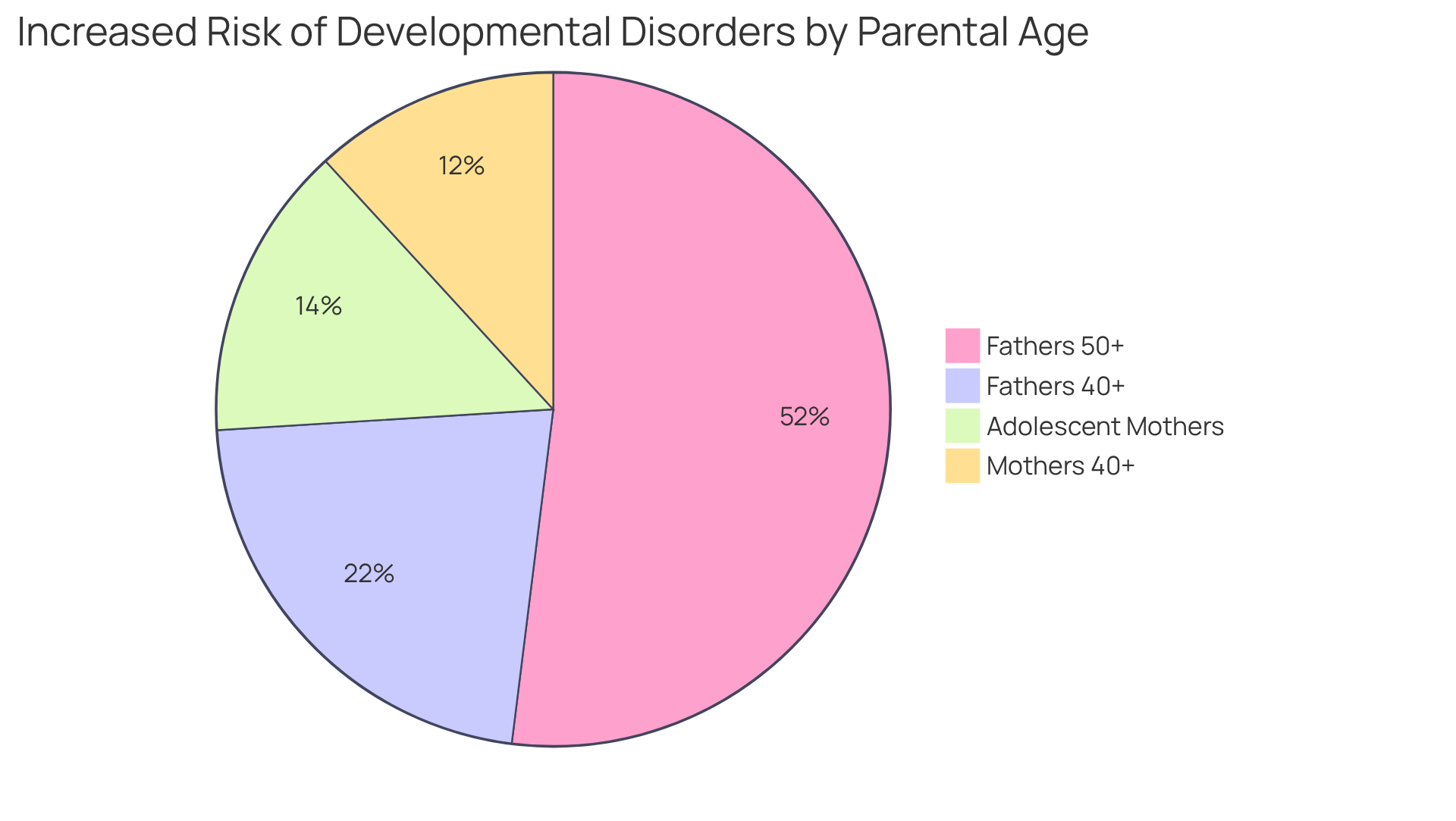
Early Diagnosis: The Key to Effective Autism Intervention
Recognizing the early signs of autism is crucial for ensuring effective intervention. Research consistently shows that children diagnosed before the age of 3 tend to have significantly better developmental outcomes compared to those diagnosed later. For instance, studies indicate that:
- Approximately 65% of children diagnosed before 2.5 years show improvements in core symptoms.
- Only 23% of those diagnosed afterward experience similar benefits.
Alarmingly, the average age for first intervention in the U.S. is 4.7 years, revealing a concerning gap between diagnosis and necessary support.
Early intervention takes advantage of neuroplasticity, which can greatly enhance communication, social skills, and overall quality of life. A compelling study from Israel further underscores the advantages of early diagnosis, reinforcing the necessity for timely evaluations. If you notice developmental delays or atypical behaviors in your child—such as a lack of eye contact or delayed speech—it's vital to seek evaluations promptly. Taking timely action can profoundly impact your child's future and well-being. Remember, you are not alone in this journey; support is available, and your proactive steps can make a significant difference.
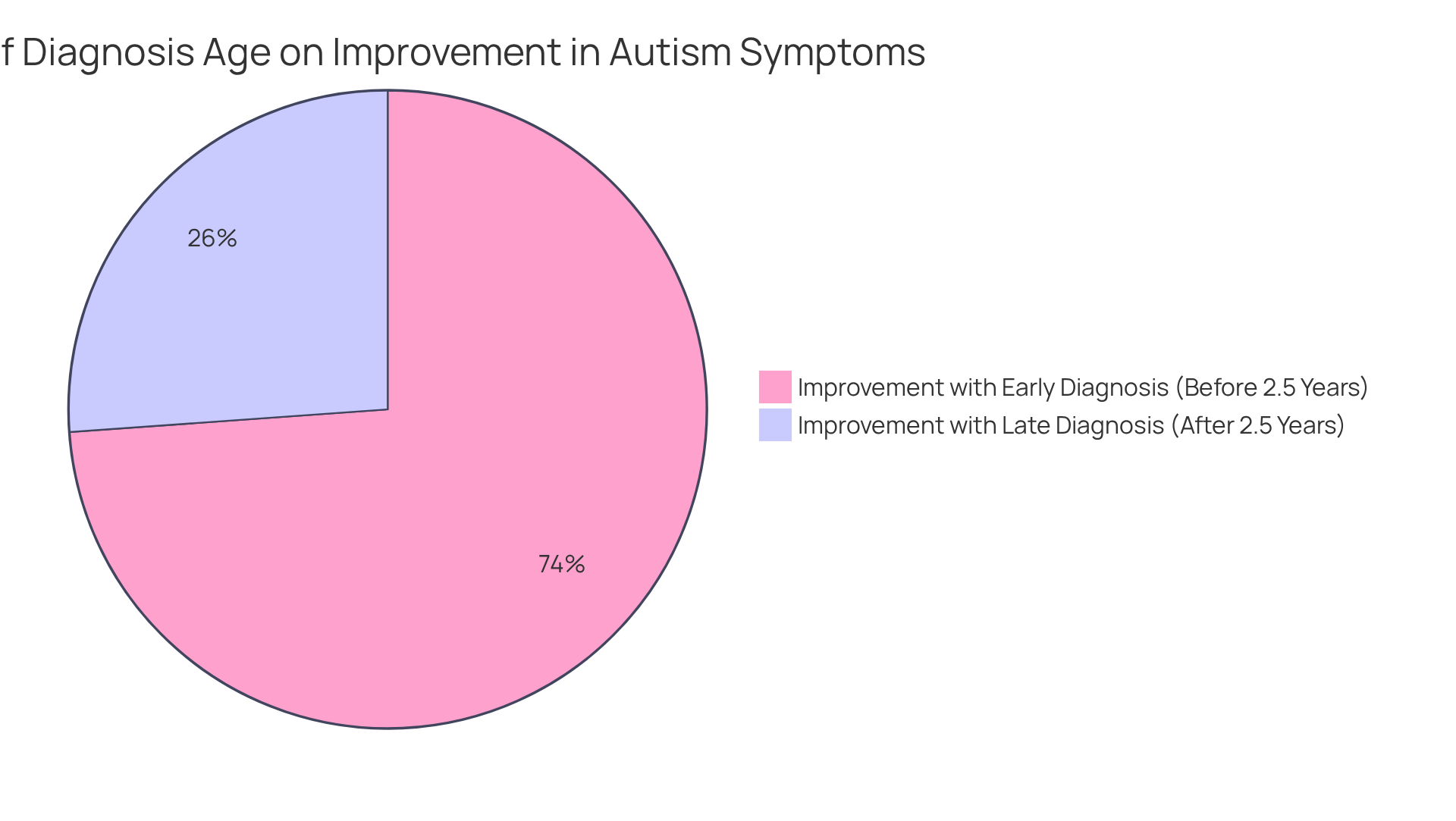
Life Expectancy and Autism: Understanding the Challenges
Research indicates that individuals with autism spectrum disorder often face a significantly lower life expectancy compared to the general population, typically living 16 to 20 years less. This statistic, while widely reported, can be misleading; some studies suggest an average life expectancy as low as 39 years, with others reporting around 54 years. Such disparities are influenced by various factors, including co-occurring health conditions like genetic disorders, sleep issues, and gastrointestinal problems, which complicate overall health outcomes.
Moreover, social isolation and mental health challenges, such as anxiety and depression, further exacerbate these issues, leading to poorer health outcomes. Limited access to healthcare services plays a critical role as well—difficulties in obtaining timely medical attention can delay the identification and treatment of common health conditions, consequently increasing mortality risk. For instance, communication barriers may hinder effective interactions with healthcare providers, resulting in unmet health needs.
Understanding these multifaceted challenges is essential for caregivers and healthcare professionals. It empowers them to create comprehensive support plans that address both the physical and mental health needs of autistic individuals. By focusing on enhancing healthcare accessibility, addressing co-existing conditions, and advocating for improved service design and enforcement of equality laws, we can work towards bettering the overall well-being and life expectancy of individuals on the spectrum. Together, let’s strive to foster a more inclusive and supportive environment for those who need it most.
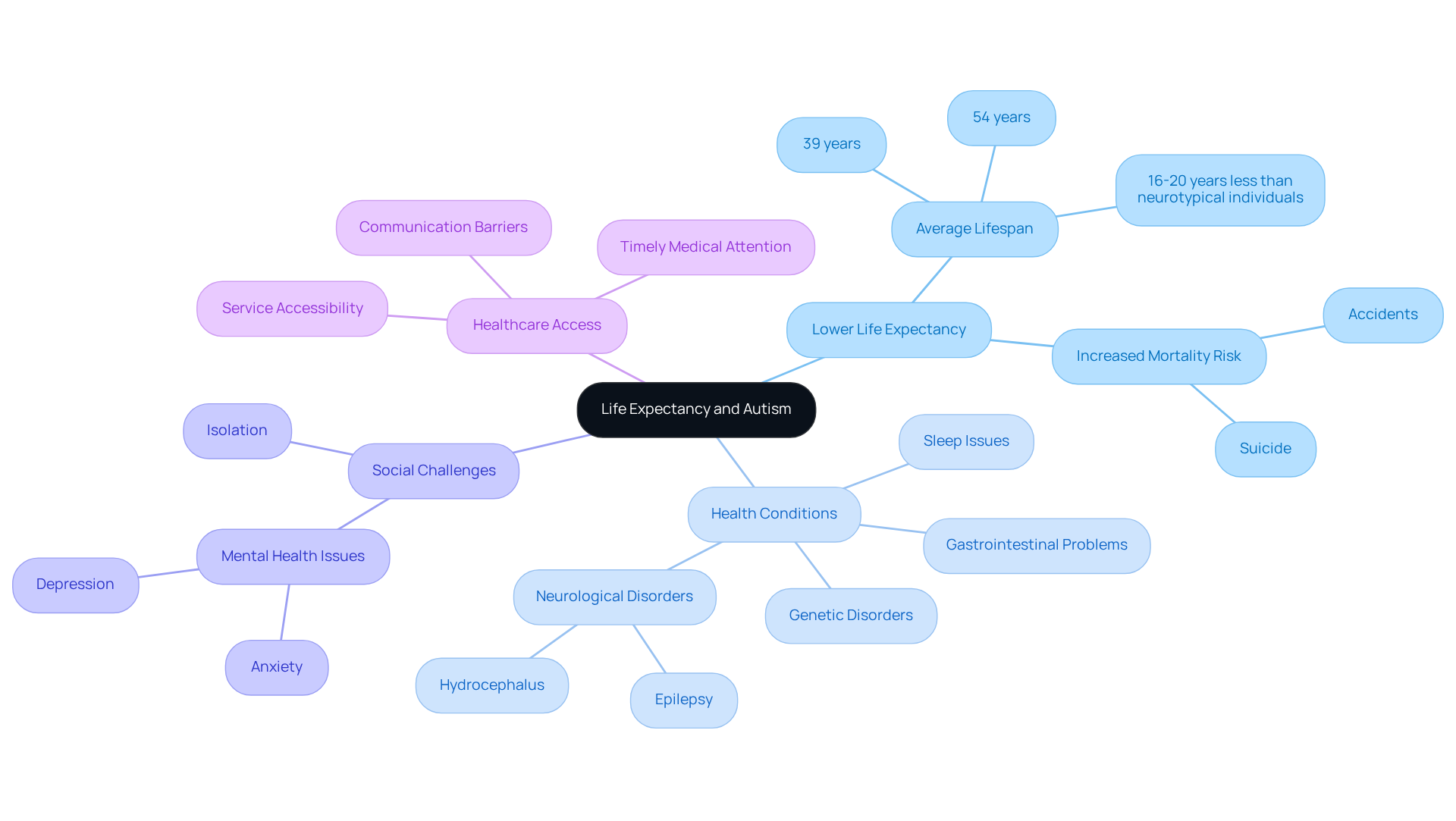
ABA Therapy: A Proven Approach to Autism Treatment
Applied Behavior Analysis (ABA) therapy is recognized as a gold-standard intervention for children with spectrum disorders, and for good reason. Many parents find it heartening to know that studies show children receiving ABA therapy often make remarkable strides in their communication, social skills, and adaptive behaviors. This therapy focuses on nurturing positive behaviors and teaching new skills through structured interventions, which can be incredibly beneficial for both children and their families.
As parents, it’s natural to seek the best for your child. ABA therapy stands out as a primary approach that can lead to meaningful improvements. By reinforcing positive behaviors, it not only helps children learn but also fosters a supportive environment where they can thrive. It’s important to recognize that you are not alone in this journey; many families have walked a similar path and found success with ABA.
If you’re considering interventions for your child with developmental disorders, we encourage you to view ABA therapy as a vital option. Engaging with professionals who specialize in ABA can provide you with the guidance and support you need. Remember, every step you take in seeking help is a step toward a brighter future for your child.
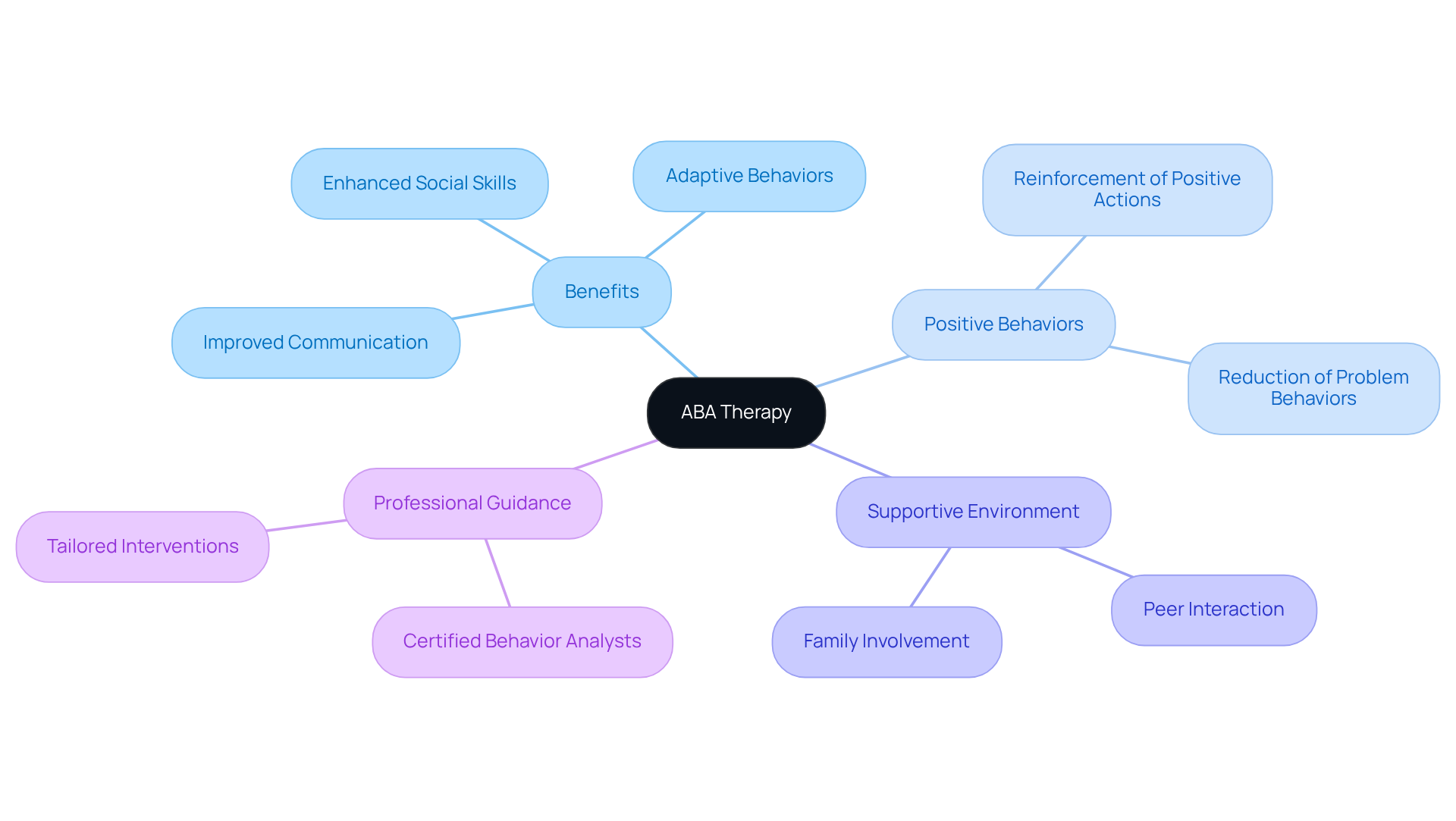
Co-occurring Conditions: Understanding Epilepsy in Autistic Children
Epilepsy often coincides with developmental disorders, affecting around 30% of individuals in this group. This connection is not just a statistic; it reflects the real struggles many families face. The interplay between neurodevelopmental disorders and epilepsy is intricate, influenced by shared genetic and neurological factors that contribute to both conditions.
Research shows that youngsters with neurodevelopmental disorders face a notably increased risk for epilepsy compared to the broader population. In fact, studies indicate that approximately 23% of these individuals are diagnosed with epilepsy, a rate significantly greater than the estimated 0.5-1.0% in the general youth population. This heightened prevalence highlights the significance of careful monitoring and customized treatment approaches for youngsters dealing with both conditions.
Understanding this connection is essential for parents and healthcare providers, as it facilitates timely interventions and comprehensive care that address the unique challenges posed by co-occurring conditions in individuals with 1 in 36 autism and epilepsy. As Ayesha Akhtar, Director of Health Equity at the Epilepsy Foundation of Greater Chicago, emphasizes, a collaborative care team is vital for supporting the mental, behavioral, and neurological health of children navigating these complexities. Together, we can ensure that every child receives the support they need to thrive.
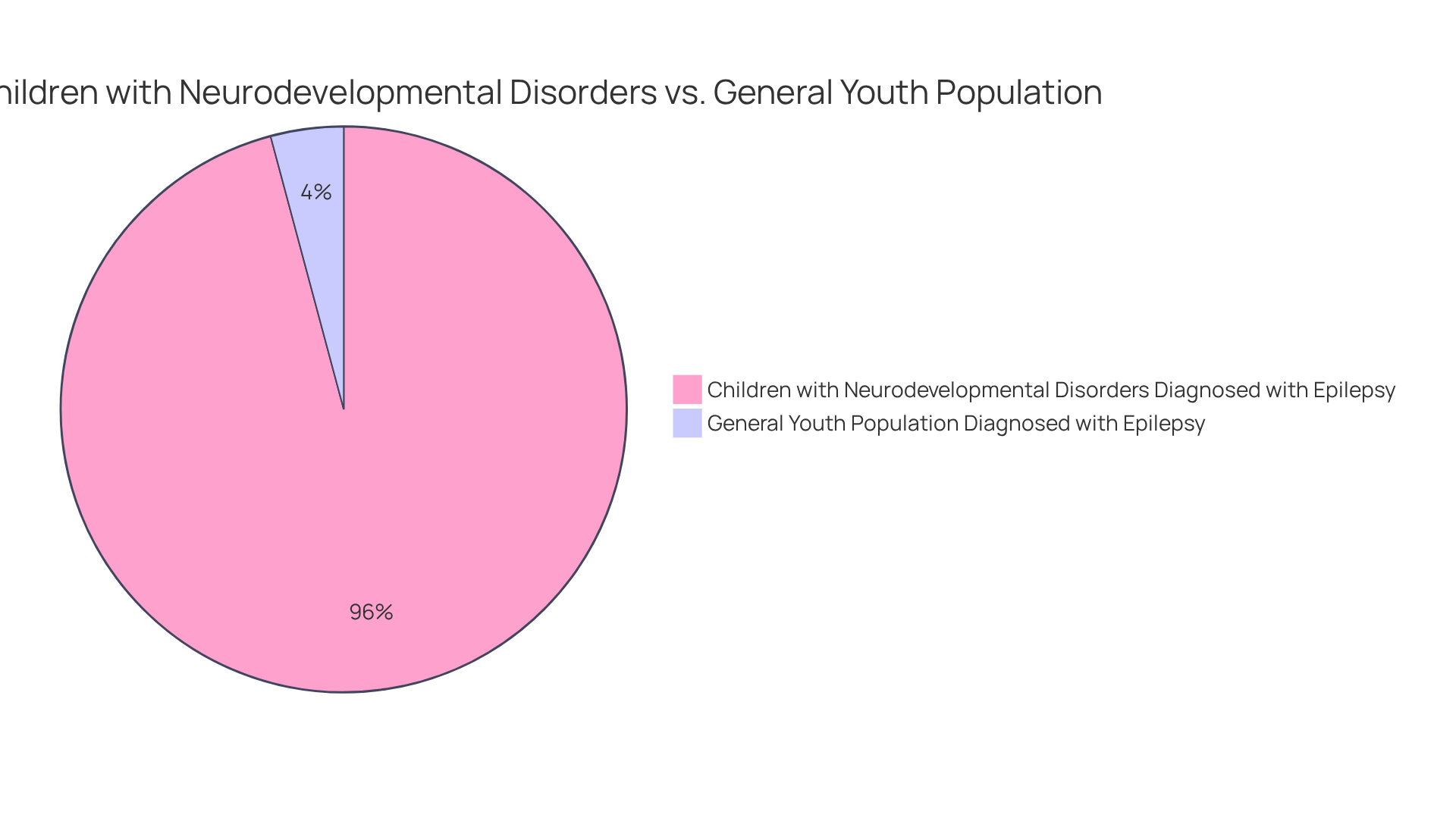
Vocational Rehabilitation: Supporting Autistic Youths in Transition
Vocational rehabilitation programs play a vital role in supporting autistic youths as they transition into adulthood. These initiatives focus on recognizing each individual's unique strengths and interests, providing tailored job training, and facilitating meaningful employment opportunities. By equipping autistic individuals with essential skills and guidance, vocational rehabilitation significantly enhances their chances of securing fulfilling employment and achieving independence.
Research indicates that effective job training programs can lead to nearly 60% of participants finding employment. This statistic underscores the importance of structured support in navigating the workforce. Moreover, successful programs often include mentorship and peer support. Advocates emphasize that "mentorship and support networks help autistic employees navigate workplace challenges," reinforcing the value of community in this journey.
Investing in job training not only empowers autistic individuals but also enriches workplaces with diverse perspectives and talents. This approach addresses the economic implications of low employment rates among autistic individuals, fostering a more inclusive and supportive environment for all. Together, we can create pathways to success for our autistic youth, ensuring they are equipped to thrive in their professional lives.
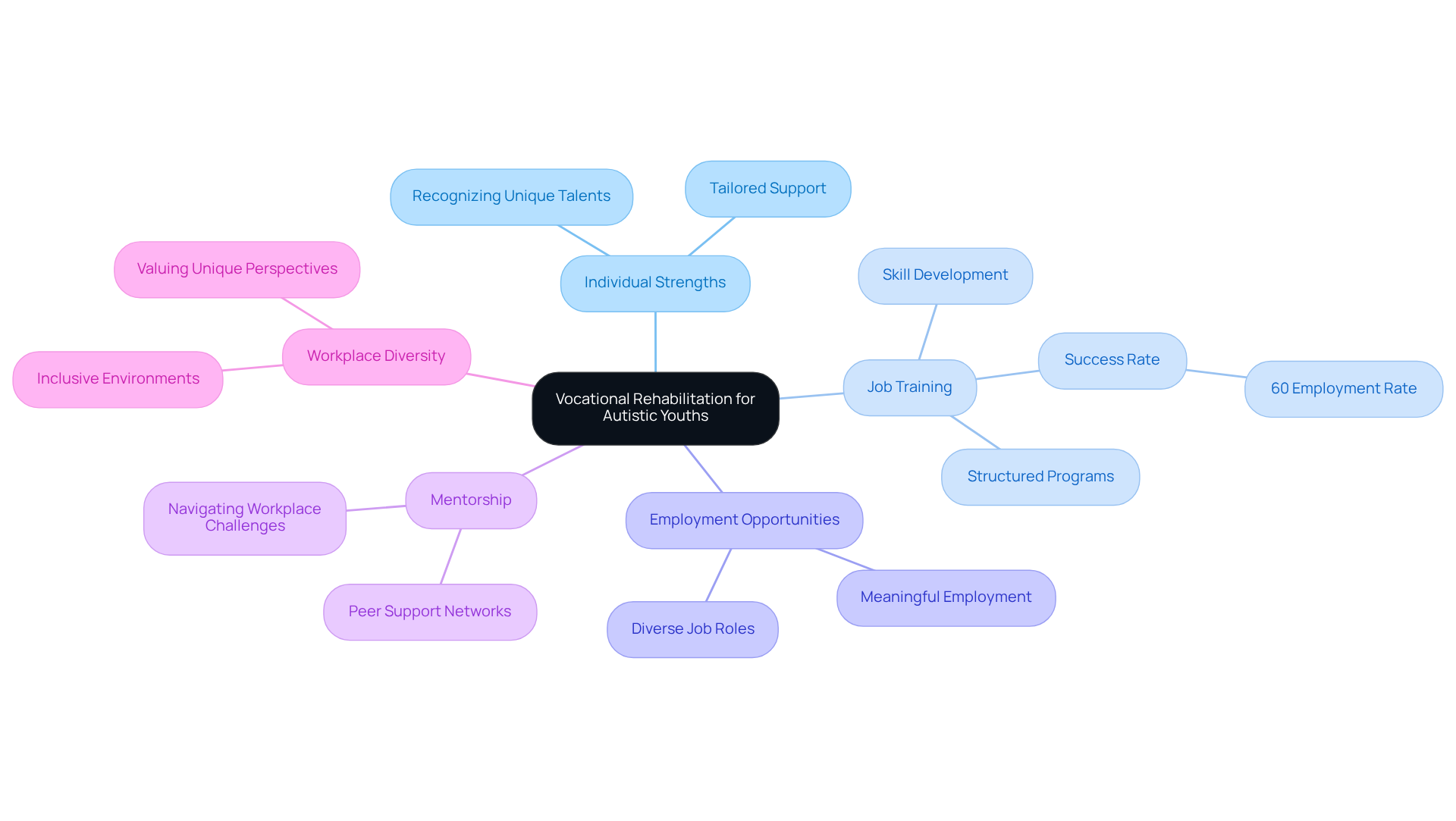
Conclusion
The rising prevalence of autism, now identified in 1 in 36 children in the U.S., highlights a critical need for effective support systems and interventions. This statistic not only reflects an increase in diagnoses but also a growing awareness and understanding of autism spectrum disorder (ASD). As families navigate these challenges, it becomes essential to focus on early diagnosis, tailored interventions, and comprehensive support for both children and adults on the spectrum.
Key insights from the article reveal significant trends in autism diagnosis, including the alarming rise in cases among young adults and the disparities in diagnosis rates between genders. The impact of parental age on autism prevalence further underscores the importance of informed family planning. Moreover, early intervention, such as Applied Behavior Analysis (ABA) therapy, is crucial for improving developmental outcomes. Understanding co-occurring conditions like epilepsy and the role of vocational rehabilitation in supporting autistic youths transitioning into adulthood is equally vital for fostering a supportive environment.
Ultimately, raising awareness and advocating for better resources and support systems can lead to improved outcomes for individuals with autism. Engaging with community initiatives, utilizing available resources, and promoting understanding can empower families and individuals on the autism spectrum. Together, we can foster a culture of acceptance and support, making a significant difference in the lives of those affected by autism and paving the way for a more inclusive future.
Frequently Asked Questions
What is the mission of ASD Media?
ASD Media is committed to enhancing the application of Applied Behavior Analysis (ABA) therapy by providing insights and strategies to address challenges faced by individuals with developmental disorders, ultimately improving their outcomes.
What statistics highlight the need for autism support?
As of 2023, 1 in 36 children in the U.S. are diagnosed with autism, a significant increase from 1 in 150 in 2000. Additionally, 78% of autistic children have at least one manageable mental health condition, emphasizing the need for comprehensive support systems.
How does ASD Media support parents and professionals?
ASD Media offers a wide range of resources designed for both parents and professionals, equipping them with effective strategies for managing challenging behaviors, navigating assistance services, and fostering social skills development.
What are the financial implications for families with children diagnosed with autism?
The average annual medical expenses for Medicaid-enrolled children with autism spectrum disorder (ASD) are approximately $10,709 per child, indicating a significant financial burden on families.
What challenges do children with autism face in social settings?
Over 60% of children with autism spectrum disorder experience bullying, highlighting the social hurdles they encounter.
What is the employment situation for adults on the autism spectrum?
Only 14% of adults on the autism spectrum are employed, indicating ongoing challenges that may concern parent advocates about their children's futures.
What recent trends have been observed in autism diagnoses among young adults?
There has been a 450% increase in developmental disorder diagnoses among young adults aged 26 to 34 over the past decade, emphasizing the need for awareness and support for this demographic.
What unique challenges do young adults with autism face?
Young adults with autism often encounter challenges with social integration, restricted job opportunities, and increased mental health concerns, which can impede their ability to achieve independence.
How can parents and professionals stay informed about autism support?
By subscribing to ASD Media's newsletter, individuals can stay informed about the latest advancements in support for individuals with developmental disorders and gain unlimited digital access to essential resources.




